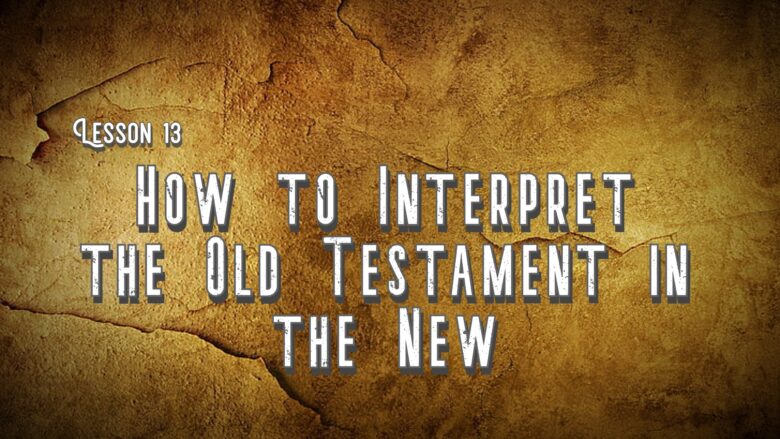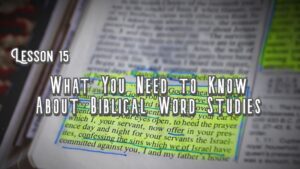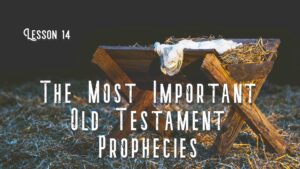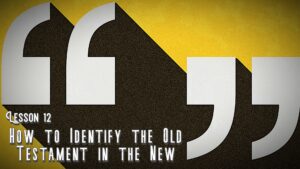Once you have identified a New Testament passage that references the Old Testament, it is time to learn how to go about interpreting such a reference. Consider Psalm 2:7. This verse was very important to the New Testament prophets based on how much it is referenced, but how does the Holy Spirit expect one to understand Psalm 2:7 when referenced in a NT context?
“When a text from the Old Testament was quoted by a New Testament author, it was not simply lifted from its context and applied to the new Christian situation. Rather…the early Christians cited texts with the wider context in mind,” (Rodgers 27).
In other words, when the voice of God in Mark 1:11 alludes to the prophecy of Psalm 2:7, the audience is being invited to go back to Psalm 2, consider what this psalm meant to its original audience, and then realize this original meaning is the foundation for the Father saying to Christ in Mark 1:11, “You are My beloved Son, in whom I am well pleased.”
7 Keys to Interpreting the OT in the NT
The titles and outline for these seven keys of interpretation were derived from chapters in the book Exploring the Old Testament in the New by Peter Rodgers.
1. Form
How does the OT passage appear in the NT? Sometimes the NT author does not quote the OT word for word when the two texts are placed side by side (i.e. Acts 2:17-21 & Joel 2:28-32). Sometimes the discrepancy may simply be related to the NT writer using a different translation than the original OT author. At other times, perhaps the NT author is providing some inspired commentary, thus shedding new light on the original text.
2. Introduction
How does the NT writer introduce the OT passage? Sometimes the NT writer uses an introductory formula such as, “As it is written…” This announces the OT prophecy with great pizazz. Whenever the NT writer skips the introductory formula and chooses to reference an OT text by subtle allusion or even echo, perhaps the reader is expected to pay more attention. In other cases, perhaps the Holy Spirit’s subtle echo back to Psalm 2:7 in Mark 1:11 is helpful for a 21st century reader twice removed from that time and culture to understand how familiar Jesus’ audiences were with this Messianic psalm. If Jews were so familiar with this psalm that even a three-word echo sparked their memory, perhaps this reveals the importance this psalm played in the earnest expectation of Messiah in Jesus’ day.
3. Selection
Why did the NT writer choose this OT passage? This goes back to considering the original context of the OT passage. For example, Paul quotes Habakkuk 2:4 in Romans 1:16 saying, “The just shall live by faith.” Why did Paul choose this OT passage? Go back to Habakkuk, and you understand that Habakkuk was writing to Israelites in Babylonian captivity. While the Babylonians were proud, trusting in their own might rather than the true God, Israel was to maintain faithfulness to God. Paul is saying the same thing as Habakkuk, “Remain faithful, continue to trust in God, and you will live.” Paul chose Habakkuk, because the context of Habakkuk’s message and the message in itself fit hand-in-hand with Paul’s message to the Roman churches.
4. Application
How does the NT writer’s application of an OT passage affect the meaning of that OT passage? This was briefly discussed under “Form.” Consider this example of Jesus applying OT prophesy to His death on the cross. In John 19:36, Jesus applies a passage from Exodus 12:46 about the Passover lamb to Himself. If prior to reading John 19:36, you did not realize the Passover lamb was symbolic of Jesus, this application by Jesus Himself should transform your understanding of the original passage. This is very helpful when considering much more difficult prophecies in the OT.
5. Combination
Is the NT writer combining multiple OT passages? This is also called a midrash (see Lesson 12). When multiple OT passages are grouped together such as already illustrated in Mark 1:11, they help interpret one another. Mark combined Exodus 23:20, Malachi 3:1, and Isaiah 40:3. If you can find out what one of these passages is teaching it will help you understand the other two. This in turn will help shed light on the NT passage where they are quoted. You might call this a give and take relationship.
6. History
Understanding history about the worlds of the New Testament and Old Testament can often help in understanding why a NT writer alludes to an OT passage. History from 300 B.C. to the time of Christ is very revealing about Messianic expectations. Many false messiahs arose and were killed as insurrectionists during this silent period between the old and new covenants. This might change one’s perspective of John the Baptist and Jesus who come preaching about the Messianic kingdom. So ask yourself, “Does the history of the time period I am studying help shed any light on this chapter or verse under consideration? This question has the tendency to open many doors of speculation. Be careful when reading historians of the Bible worlds. Distinguish between when the historian reports the facts and when he reports his interpretation of the facts. Just because something was culturally prevalent in Judea during Jesus’ day doesn’t necessarily mean Jesus partook in whatever it was. Nonetheless, learning biblical history will remind you to ask this question more often.
7. Story
How does this NT quotation or allusion of the OT help me better understand the story of the Bible? The Bible is a story with a running plot line from Genesis to Revelation. See Lesson 11 for a review of this item. When John alludes to Genesis 1 in John 1:1-9, he helps identify the progression of the biblical plot line. We understand, things that were introduced in the very first chapter of the Bible are coming full circle now.
Conclusion
What have you learned? Hopefully you have learned to appreciate the great intention used by the NT authors when citing the OT. Their citations were not haphazard, the same should go for your Bible study.
Homework Questions
1. Use a separate sheet of paper to write out side by side Acts 2:17-21 and Joel 2:28-32. What differences do you find in the words or phrases of these parallel readings?
2. What are at least two reasonable explanations why Peter’s quotation of Joel in Acts 2:17-21 is not identical word-for-word?
3. In 2 Corinthians 3:7-18, Paul alludes to an Old Testament passage. What chapter from the Old Testament is the allusion drawn from? (Hint: Use your center column reference if you have one.)
4. “Jesus used the four Passover cups of Jewish tradition when He ate the last supper in the upper room during the passion week.” Does this conclusion come from simply reading the New Testament scriptures, or is this an interpretation from Jewish history around the time of Jesus? Read the last supper accounts in answering your question: Matthew 26:17-30; Mark 14:12-26; Luke 22:7-23.
Helpful Resources
The following resource is a moderately difficult read. Reading Peter Rodgers’ book without having completed reading the Bible is not advised.
Exploring the Old Testament in the New by Peter Rodgers



